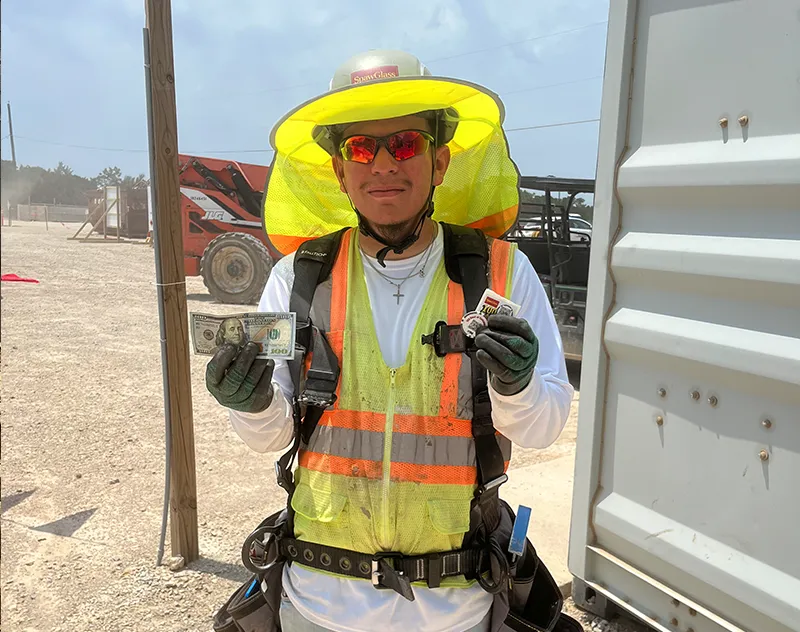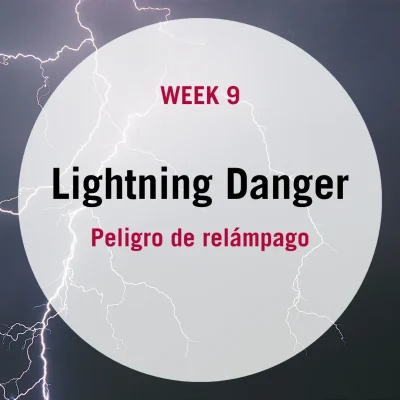
100 days of summer - week 9
Congratulations to our Week 9, 100 Days of Summer winner: Douglas Alvarado is celebrating 1 year with SpawGlass and is a Laborer in the Austin Division.
Felicitaciones a nuestro ganador de la Semana 9, 100 Días de Verano: Douglas Alvarado está celebrando 1 año con SpawGlass y es un obrero en la División de Austin.
SAFETY TIP

Lightning injures or kills hundreds of people in the U.S. each year. Construction workers who work in 1 open spaces, on roofs, or other high places are at risk of being struck by lightning.
Lightning can stop your heart and kill you. It can also cause burns, nervous system damage, and other health problems you may not notice until months after a lightning strike.
If you hear thunder …
Get into an enclosed building. If you hear even a distant rumble of thunder, the Occupational Safety and Health Administration (OSHA) says you “should get to a safe place immediately” and “remain in the shelter for at least 30 minutes after hearing the last sound of thunder.” If you can’t find a building, get into a hard-topped car or truck with the windows closed. Do not touch the doors or other metal inside.
Avoid objects that conduct electricity. (Metal objects—scaffolds, heavy equipment, or light poles, Plug-in power tools or telephones, even if indoors, Water—puddles or pipes and Trees (if the tree is hit, you can be too.)
If you are out in the open and have nowhere to go …
Squat down with your feet together. Only let your feet touch the ground. Do not sit or lie flat on the ground. Since lightning travels through the ground, the more contact you have with the ground, the greater your risk for injury or death. Use this position to reduce your risk of being struck by lightning.
Los rayos hieren o matan a cientos de personas en los EE. UU. cada año. Los trabajadores de la construcción que trabajan en espacios abiertos, en techos u otros lugares altos corren el riesgo de ser alcanzados por rayos.
Un rayo puede detener tu corazón y matarte. También puede causar quemaduras, daños en el sistema nervioso y otros problemas de salud que es posible que no note hasta meses después de la caída de un rayo.
Si oyes truenos…
Entra en un edificio cerrado. Si escucha incluso el estruendo de un trueno lejano, la Administración de Seguridad y Salud Ocupacional (OSHA, por sus siglas en inglés) dice que “debe llegar a un lugar seguro de inmediato” y “permanecer en el refugio durante al menos 30 minutos después de escuchar el último sonido de un trueno”. Si no puedes encontrar un edificio, súbete a un auto o camioneta con techo rígido y las ventanas cerradas. No toque las puertas ni ningún otro metal en el interior.
Evite los objetos que conduzcan la electricidad. (Objetos metálicos: andamios, equipo pesado o postes de luz, herramientas eléctricas enchufables o teléfonos, incluso si están en interiores, agua, charcos o tuberías y árboles (si el árbol es golpeado, usted también puede serlo).
Si estás a la intemperie y no tienes a dónde ir…
Ponte en cuclillas con los pies juntos. Solo deja que tus pies toquen el suelo. No se siente ni se acueste en el suelo. Dado que los rayos viajan a través del suelo, cuanto más contacto tenga con el suelo, mayor será el riesgo de lesiones o muerte. Utilice esta posición para reducir el riesgo de ser alcanzado por un rayo.

